What to protect crops from: pests and diseases of wheat, photo and description
Wheat gets sick for various reasons: unfavorable climate, poor care, lack of nutrients in the soil. To prevent the occurrence of diseases, farmers carry out preventive measures - they treat the plants with special solutions and apply fertilizers to the soil. The quality and quantity of the harvest is also affected by insect pests that feed on wheat juice and disrupt metabolism.
Let us consider in detail the description of wheat diseases with photos, as well as common insect pests.
Classification of diseases
There are more than 200 diseases that destroy cereal crops partially or completely. To cope with the disease, it is necessary to determine its characteristics and origin at an early stage of infection.
All diseases are divided into the following groups:
- Mushroom arise due to the appearance of fungi in the fields, which quickly spread throughout the plants and live off the nutrients in the wheat. Fungal diseases include dusty, stem and dwarf smut, rust, and powdery mildew.
- Bacterial appear due to bacteria that can destroy the entire plant or its individual part. Bacterial diseases manifest themselves on the root system, in the vessels of wheat, or are of a mixed nature. They actively develop during periods of heat and high humidity. Common representatives are basal, black and mucous bacteriosis.
- Viral appear at any stage of wheat growth. Viruses overwinter in plant debris, soil, and on insects. They are transmitted through the contact of healthy wheat with diseased wheat, through wind and seeds. A common example of a viral disease is mosaic.
- Diseases caused by insect pests. We are talking about oat and wheat nematodes. A nematode is a round small worm, the appearance of which leads to a malnutrition of wheat and the occurrence of diseases.
The most common diseases
Grain crops are susceptible to diseases as often as garden and indoor plants. To quickly cure wheat, it is recommended to know the main diseases, their characteristics and control methods.
Root rot
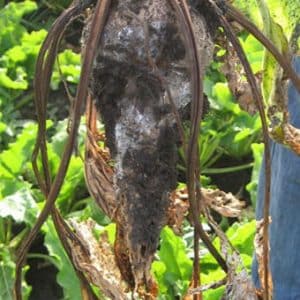
This fungal disease affects seedlings in spring, and the root collar in summer and autumn. Brown spots and stripes of varying lengths without a border appear on wheat.
Favorable conditions for the development of root rot: dry summers, prolonged rainfall, sudden weather changes.
The infection is found in the soil, plant debris, weeds and untreated seeds. Often, root rot appears at an early stage of wheat growth, which entails a 60% reduction in yield.
Powdery mildew
White and light brown spots with a black dot inside appear on wheat. The fungus infects nearby plants within 3-5 days, and soon the wheat withers and dries out.
Powdery mildew develops from the period of germination to ripening and affects any variety. The fungus quickly penetrates wheat during periods of high humidity.
To avoid the appearance of powdery mildew, it is recommended to follow the rules of crop rotation and apply organic and mineral fertilizers on time. For treatment, the fungicide “Credo” is used.
Rust
There are several types of rust. Yellow appears as small yellow-orange spots on leaves and stems. Favorable time for its development is cool spring and summer.
Stem, or linear, rust affects the plant completely, it becomes covered with brown ulcers, the stem cracks in different places, becomes soft and weak. The fungus spreads by wind and water. Capable of destroying an entire crop.
Brown and leaf rust is found throughout Russia. Thousands of small, voluminous brown spots appear on the upper side of the leaf.
Reference. To protect against any type of rust, it is recommended to choose resistant varieties for planting and follow agrotechnical rules.
Fusarium
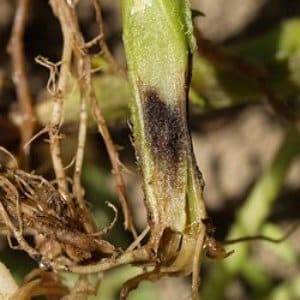
Fusarium affects the roots, stem and ear. A light pink coating and small dark spots are visible on the scales. The grains become puny and wrinkled, lose their firmness and elasticity.
Infection occurs through plant debris or through neighboring grain crops, such as corn. Fusarium actively develops during the flowering period, so farmers recommend carefully inspecting the plantings for symptoms of the disease. They get rid of fusarium with the help of Kolosal.
Pyrenophorosis
Pyrenophorosis, or yellow spot, is characteristic of the southern regions. Small spots of yellow and beige color appear on the leaves and stem. In the center they are light, the border is chlorotic. A week after the spots appear, the spots merge into one large pattern and the leaves dry out. If it rains, a thin light coating appears on the surface of the leaf blade.
The cause of infection of grain crops is plant residues. Yellow spot is treated with Tertia.
Ergot
The fungal disease appears as dark purple or black “horns” on wheat. The development of the fungus is promoted by long and rainy summers and an extended flowering period. Ergot spreads especially actively to plants that are planted near the road.
The source of infection is a fungus on the surface of the seeds and in the soil. For prevention, it is recommended to harvest the crop in a timely manner and carry out early plowing of the field.
Septoria
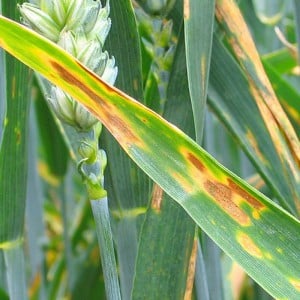
Septoria is common in regions with high humidity and prolonged rainfall. Brown marks appear on the leaves, the ear scales become covered with plaque and dry out, the stems bend and turn black.
The fungus overwinters in grass and weeds. To prevent the occurrence of septoria, regularly fertilize soil and adhere to grain planting dates.
Mob of ears
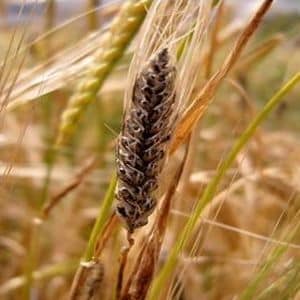
The blackness of the ear appears at the height of summer. The ear becomes covered with black dots or a dark coating; signs of the disease are easy to see with the naked eye.
The fungus is widespread everywhere, regardless of the region of cultivation.
Fungicides are used for treatment: “Rakurs”, “Talent”, “Spirit”. For preventive purposes, the crop is harvested in a timely manner and in a short time.
Pythium root rot
Fungal disease develops during periods of low temperatures and rainy weather. Pythium root rot is dangerous for wheat at an early stage of growth and development. Brown stripes and ulcers appear on the root system, and root hairs disappear. Seedlings grow crookedly or do not appear at all, wheat lags behind in growth.
Causes of infection: lack of nutrients in the soil, cold and long winter, contaminated seed.
Attention! Root rot actively develops if wheat is sown in acidic soil low in phosphorus and organic matter. Cement dust and slaked lime help reduce soil acidity. Before planting, the soil is fertilized with phosphorus-containing fertilizers: “Superphosphate”, “Ammophos”, phosphate rock or bone meal.
Wheat pests
Insect pests of grain crops can destroy the entire crop. Insect larvae overwinter in the soil, and with the onset of warm weather they appear on the ground.
Wireworm
Wireworms are found in heavy and clayey soils. It received its name for its external resemblance to yellow and thick wire. Larvae and adults feed not only on humus, but also on underground parts of wheat, which disrupts the metabolism in the plant and slowly dies. Adult wireworms lay eggs in moist soil.
To prevent the appearance of the pest, lime the soil, apply ammonia fertilizers, and feed with Bazudin. The soil is dug up, wireworms are collected by hand and burned.
Pjavica
Flying beetles, 5 mm long, are ubiquitous. They appear in April, eat narrow holes in the leaves and suck out the juice. Wheat stops growing and dries out, making it impossible to restore the harvest. Adults and larvae damage the crop.
Beethorn spreads quickly in warm, wet spring conditions. For prevention, resistant varieties and promptly destroy cereal weeds - wormwood, mouse peas, chicken millet.
Hessian fly
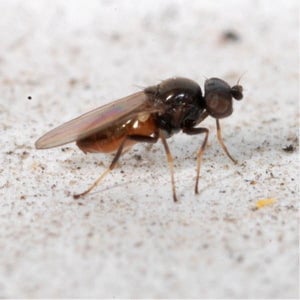
The pest overwinters in the stems of wheat and weeds, and flies out at the end of April or beginning of May.
Wheat affected by the fly has a yellow stem and dries out.To prevent the appearance of Hessian flies, the seeds are treated and planted in prepared loose soil. Get rid of the insect using the drug “Cruiser” or “Ephoria”.
Wheat thrips
Black bugs 2 mm long infect spring wheat. They overwinter in fields and develop on ears of corn for 10-14 days in spring. They damage the leaves and suck out the juice, as a result of which light spots appear on the plates, the ears become deformed, become fluffy and loose. The grain becomes smaller, and black dots appear in places where thrips bites.
Wheat thrips reproduce quickly in dry and warm summers. They get rid of them with the help of the drug “Bazudin”.
Bread ground beetle
Beetles 2 cm long damage winter wheat varieties. They chew off leaves and damaged plants dry out. The ground beetle often appears in areas where the wheat planting site has not been changed for more than three years. Insects eat the grains and gnaw off the scales. For prevention, the timing of sowing and harvesting is observed.
Diseases and pests affecting winter and spring wheat
Winter wheat takes 3 times longer to ripen than spring wheat. Winter productivity depends on the application of mineral fertilizers and the nutritional composition of the soil. Its root system is more sensitive, so winter varieties are more often susceptible to root rot, rust and fusarium. In areas with winter varieties, wireworms are often found; they feed on roots and suck out nutrients.
Spring wheat has a powerful root system, but such wheat is more sensitive to sudden changes in weather. As a result, fungi and bacteria develop, and the plantings become infected with black spot, septoria, and powdery mildew. Thrips, Hessian flies and bread ground beetles appear in the beds.
Fighting methods
To effectively combat diseases and pests, professional preparations are used.
Farmers recommend:
- Fungicides “Zantara”, “Prozaro”, “Soligor”, “Falcon”, “Input”. The drugs strengthen the immunity of wheat and treat fungal and viral diseases.
- Insecticides “Decis Expert”, “Confidor Extra”, “Proteus” protect against pests and prevent the appearance of rodents in wheat fields.
- Herbicides “Ballerina”, “Gorgon”, “Deimos”, “Demeter” help preserve nutrients in the soil and protect against weeds.
Preventive measures
For preventive purposes, disease-resistant wheat varieties are chosen for planting: Prestige, Rodnik Tarasovsky, Governor Don, Galina. Farmers observe the planting dates for winter and spring varieties, disinfect seeds and soil, and adhere to the following rules:
- For planting, choose chernozem or chestnut lands;
- before planting, the soil is peeled;
- wheat is planted after legumes and row crops;
- fertilize the soil with nitrogen;
- Weeds are removed regularly.
Read also:
Maximum benefits in one glass: prepare and drink wheat germ juice correctly.
Description and characteristics of the winter wheat variety “Bagrat”.
Conclusion
To protect your wheat from diseases and insects, it is recommended to know their signs and symptoms. For example, powdery mildew is recognized by a white coating, and a wireworm infestation is recognized by damaged roots. Most larvae and fungi live in the soil and wait out the autumn and winter there.
Viral, fungal and bacterial diseases actively develop in heat and rain, insects appear when agrotechnical rules are not followed. Fungicides and insecticides help get rid of them.